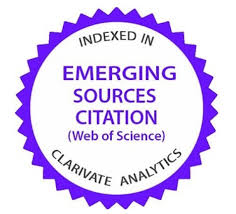Breastfeeding and social, cultural, geopolitical embodied barriers
Palabras clave:
medical anthropology, infectivology, transdisciplinary, latin AmericaResumen
This study in medical anthropology was conducted at the National Institute for Health, Migration and Poverty (INMP), in Rome, Italy, and was carried out in 2013-2014 as part of the project “Clinical and social evaluation of medical practices in the treatment of infectious diseases in paediatrics for children of vulnerable populations”. At the end of the project, it was possible to ensure diagnostic accuracy, the proper prescription of antibiotic therapy and improve family care of children affected by pharyngotonsillitis. In addition, it was possible to acquire knowledge of the health of children with respect for certain social determinants. The anthropological research targeted mother’s of children and adolescents from the age of 3 to the age of 17 immigrated to Rome from Africa: sub-Saharan and North; furthermore from Asia: Indian subcontinent, West Asia, Eurasia, Middle East, Arabian peninsula; South-East Europe; Centre and South America. In this article we’ll consider only mother’s of 39 children and adolescents from Latin America (Argentina, Brazil, Colombia, Ecuador, El Salvador, Honduras, Nicaragua, Paraguay, Peru, Dominican Republic, Uruguay and Venezuela). The study aimed at analysing the formation and the socio-cultural representation, which emerged from interviews of women regarding barriers to breastfeeding; the effects of breastfeeding on the psychological and physical health of infants; the social and domestic consequences, which affect women who did not stop breastfeeding when they feel they should have.
In Italy, as in other destination countries for global migrations, barriers that prevent the access to the healthcare system must be removed, barriers that are accentuated by linguistic and cultural incomprehension, through adequate multidisciplinary healthcare settings such as the onetransdisciplinary we are presenting, composed of a medical doctor, an anthropologist and a cultural mediator.1
Descargas
Citas
Adami, L. C., Gabrielli, O., Zaffaroni, M., Cataldo, F., Valentini, P., Veneruso, G. y Zavarise G. (2007). Protocollo diagnostico assistenziale per l’accoglienza sanitaria del bambino adottato all’estero. Obtenida el 15 de noviembre 2013, de http://www.glnbi.org
Baer, R. D. y Penzell, D. (1993). Research report: susto and pesticide poisoning among Florida farmworkers. Cult Med Psychiatry, 17(3), 321-327.
Barnett, E. D. (2005). Immunizations and infectious disease screening for internationally adopted children. Pediatr Clin North, 52(5), 1287-1309.
Beneduce, R. (2007). Etnopsichiatria. Sofferenza mentale e alterità fra Storia, Dominio e Cultura.
Roma: Carrocci Editore.
Beneduce, R. (2010). Archeologie del trauma. Un'antropologia del sottosuolo. Bari: Editori Laterza. Burkhalter, B.R., Marin, P.S. (1991). A demonstration of increased exclusive breastfeeding in Chile.
Int J Gynaecol Obstet, 34(4), 353-359.
Castaldo, M. (2004). Susto o espanto. En torno a la complejidad del fenómeno, Dimensión Antropológica, 11, 29-67.
Castaldo, M. (2015). Susto: Etiology of Mental Disorders in Mothers and Children in Mexico.
Journal of Pregnancy and Child Health, 2(6), 1-6.
Castaldo, M., Marrone, R., Costanzo, G. y Mirisola, C. (2014). Clinical Practice and Knowledge in Caring: Breastfeeding Ties and the Impact on the Health of Latin-American Minor Migrants. Journal of Immigrant and Minority Health, 17(5), 1476-1480.
Castro, R. y Eroza, E. (1998). Research notes on social order and subjectivity: individuals' experience of susto and fallen fontanelle in a rural community in central Mexico. Cult Med Psychiatry, 22(2), 203-230.
Collado, A. R. (1988). Una enfermedad paralela: el susto. México: Universidad Nacional Autónoma de México.
Donlan, W. y Lee, J. (2010). Coraje, nervios, and susto: Culture-bound syndromes and mental health among Mexican migrants in the United States. Advances in Mental Health, 9(3), 288-302.
DuPlessis, H. M. y Cora, B. D. (2005). American Academy of Pediatrics Committee on Community Health Services: Providing care for immigrant, homeless, and migrant children. Pediatrics, 115(4), 1095-1100.
Fanon, F. (1959). Pour la révolution africaine. Écrits politiques, Paris: Éditions La Découverte.
Fassin, D. (2006). La biopolitica dell’alterità. Clandestini e discriminazione razziale nel dibattito pubblico in Francia. En I. Quaranta (Ed.). Antropologia medica. I testi fondamentali, (303- 322). Torino: Raffaello Cortina.
Fassin, D. y D’Hallouin, E. (2005). The Truth from the Body: Medical Certificates as ultimate evidence for asylum Seekers. American Anthropologist, 107(4), 597–608.
Fassin, D. y Rechtman, R. (2007). L'Empire du traumatisme. Enquete sur la condition de victime.
Paris: Flammarion.
Forman, M. R., Lewando, H. G., Graubard, B. I., Chang, D., Sarov, B., Naggan, L. y Berendes, H. W. (1992). Factors influencing milk insufficiency and its long-term health effects: the Bedouin Infant Feeding Study. Int J Epidemiol, 21(1), 53-58.
Guerrero, M. L., Morrow, R. C., Calva, J. J., Ortega, G. H., Weller, S. C., Ruiz, P. G. M. y Morrow, A. L. (1999). Rapid ethnographic assessment of breastfeeding practices in periurban Mexico City. Bull World Health Organ, 77(4), 323-330.
Hunt, L. M. y Arar, N. H. (2001). An analytical framework for contrasting patient and provider views of the process of chronic disease management. Medical Anthropology Quarterly, 15(3), 347-367.
Hurtado, E. (1989). Breast feeding in the etiology of diarrhea. Archivos Latinoamericanos de Nutrición, 39(3), 278-291.
IDOS. (Ed.). (2015). Dossier Statistico Immigrazione 2015. Roma: IDOS, UNAR.
James, J. P., Taft, A., Amir, and L.H., Agius, P. (2014). Does intimate partner violence impact on women's initiation and duration of breastfeeding? Breastfeed Rev, 22(2), 11-19.
Johnson, N. L. y Johnson, D. M. (2013). Correlates of Readiness to Change in Victims of Intimate Partner Violence. Journal of Aggression, Maltreatment & Trauma, 22(2), 127-144.
Labbok, M. H. (2013). Breastfeeding: population-based perspectives. Pediatr Clin North Am, 60(1), 11-30.
Li, R., Dee, D., Li, C. M., Hoffman, H. J., Grummer, S. L. M. (2014). Breastfeeding and risk of infections at 6 years. Pediatrics, 134(1), 13-20.
Mabilia, M. (2000). The cultural context of childhood diarrhoea among Gogo infants. Anrthopolgy & Medicine, 7(2), 191-208.
Malkki, E. H. (1995). Refugees and Exile: From ‘Refugee Studies’ to the National Order of Things.
Annual Review of Anthropology, 24, 495-523.
Mendenhall, E., Fernandez, A., Adler, N., y Jacobs, E.A. (2012). Susto, coraje, and abuse: depression and beliefs about diabetes. Cult Med Psychiatry, 36(3), 480-492.
Miller, L. C. (2005). International adoption: infectious diseases issues. Clinical Infectious Diseases,
(2), 286-293.
Mull, D. S. (1992). Mother's milk and pseudoscientific breastmilk testing in Pakistan. Soc Sci Med, 34(11), 1277-1290.
Mysyk, A. (1998). Susto: an illness of the poor. Dialectical Anthropology, 23(2),187-202.
Palma, N. H., y Torres, V. G. (1974). Propuesta de un criterio antropológico para una sistematización de las componentes ‘teóricas’ de la medicina popular, a propósito de la enfermedad del susto. Relaciones de la Sociedad Argentina de Antropología, 8, 161-171.
Pan American Health Organization (PAHO) and World Health Organization (WHO) (2013). “World Breastfeeding Week 2013 Breastfeeding Support: Close to Mothers. Accessed October 21 2014. http://worldbreastfeedingweek.org/2013/
Patel, S. R. (2013). Primary Care Professional's Perspectives on Treatment Decision Making for Depression with African Americans and Latinos in Primary Care Practice. J Immigr Minor Health, 16(6), 1262-1270.
Rubel, A., O'Neill, C., y Collado, A. R. (1995). Susto, una enfermedad popular. México: Fondo de Cultura Económica.
Seijas, H. (1972). El susto como categoría etiológica. Científica venezolana, 23(3), 176-178.
Signorini, I., y Alessandro, L. (1989). Los tres ejes de la vida. México: Universidad Veracruzana.
Simons, R. C. (1985). The fright illness taxon (329-331). The Culture-Bound Syndromes. Folk Illness of Psychiatric and Anthropological Interest, 7, 329-331.
Simons, R. C., y Hughes Charles, C. (1985). The Culture-Bound Syndromes. Folk Illness of Psychiatric and Anthropological Interest. Holland & Boston: Dordrecht.
Tenorio, S. L. (2014). Culturally Sensitive Approaches to Recruitment and Retention of Hispanics in the National Lung Screening Trial. J Immigrant Minor Health, 16(4),761-764.
World Health Organization. (Ed.). (1981). Collaborative Study on Breast-feeding: Contemporary patterns of breast-feeding. (Report on the WHO Collaborative Study on Breast-feeding). Geneva: World Health Organization.
Wikan, U. (1999). Debate, Culture: A new concept of race. Social Anthropology, 7(1), 57-64.
Yépez del Castillo, I., Herrera, G. (2007). Nuevas migraciones latinoamericanas a Europa. Balances y desafíos, Flacso, Obreal, UCL, UB.
Zempléni, A. (1987). La maladie et ses causes: Causes origins et agents de la maladie chez les peuples sans écriture. L'Homme, 27(103), 141-142.
Zuñiga, J. A. (2012). Medication adherence in Hispanics to latent tuberculosis treatment: a literature review. J Immigr Minor Health, 14(1), 23-29.
Descargas
Publicado
Cómo citar
Número
Sección
Licencia

Esta obra está bajo una licencia internacional Creative Commons Atribución-NoComercial 4.0.
Usted es libre de:
- Compartir — copiar y redistribuir el material en cualquier medio o formato
- Adaptar — remezclar, transformar y construir a partir del material
- La licenciante no puede revocar estas libertades en tanto usted siga los términos de la licencia
Bajo los siguientes términos:
- Atribución — Usted debe dar crédito de manera adecuada , brindar un enlace a la licencia, e indicar si se han realizado cambios . Puede hacerlo en cualquier forma razonable, pero no de forma tal que sugiera que usted o su uso tienen el apoyo de la licenciante.
- NoComercial — Usted no puede hacer uso del material con propósitos comerciales .
- No hay restricciones adicionales — No puede aplicar términos legales ni medidas tecnológicas que restrinjan legalmente a otras a hacer cualquier uso permitido por la licencia.








